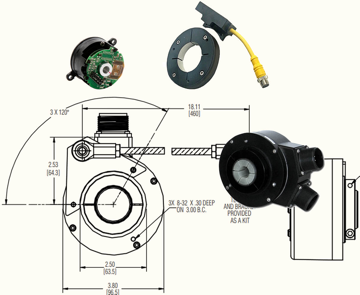A pull up resistor is used to "pull" the logic high voltage level up to the level of the operating voltage. This is useful when the output of the Open Collector is not reaching the voltage level needed to indicate a logic high signal or when noise is present on the signal line. When a logic high signal is present its voltage level will be approx. that of the operating voltage for an open circuit. The difference is due to the voltage drop across the pull-up resistor. This is not necessarily true if the load is referenced to ground.
Why Do I Need a Pull-Up Resistor?
Posted by London Rhodes on Apr 19, 2021 12:30:19 PM
What is a Quadrature Output?
Posted by London Rhodes on Apr 19, 2021 11:41:49 AM
Quadrature output refers to the fact that the signals A and B are separated by 90 degrees of phase shift with A leading B or B leading A depending on the direction of rotation. It does not mean that the output will be 4 times the amount of the Pulses Per Revolution of the encoder. The fact that the signals are 90 degrees out of phase enables the controller to determine the direction that the encoder is spinning. You must use both the A and B signal to have a quadrature output and to get X2 or X4 logic. (see What is the difference between Quadrature and x4 Logic?)
What is a Differential Line Driver Output?
Posted by London Rhodes on Apr 16, 2021 10:30:25 AM
A differential output refers to the fact that each channel has a complement channel, i.e. Channel A and Channel A not. A differential line driver is used to help increase noise immunity (see What are the A not and B
Can a Dual Output Encoder Have Two Different PPRs?
Posted by London Rhodes on Mar 22, 2021 1:47:03 PM
It very possible for our dual output encoders to have multiple PPRs. All NorthStar SlimTach encoders offer different PPRs. However, the NorthStar RimTach dual output encoders must be from the same PPR family. For example, an encoder with a 256 PPR can be paired with a 512 but not a 600.
Can I Use an Anodized Aluminum Encoder in Corrosive Environments?
Posted by London Rhodes on Mar 22, 2021 11:35:33 AM
Although stainless steel is the most common choice for corrosive environments, you can also use anodized aluminum encoders. An anodized aluminum encoder is much lighter in weight than stainless steel, and offers benefits such as sulfur inertness, corrosion resistance and chemical inertness. However, it is common to paint the aluminum housing to help protect it from corrosive elements, such as salt.
Topics: How to Choose An Encoder
When Should I Use a Stainless Steel Encoder?
Posted by London Rhodes on Mar 19, 2021 3:09:07 PM
Stainless steel encoders are preferred in applications that are subject to corrosive elements. For example, salt baths and wash downs are common in the Food and Beverage industry. In this case, a stainless steel encoder is most appropriate due to its ability to withstand salt water exposure over time.
Topics: How to Choose An Encoder
What is the Difference in Single and Dual Output Encoders?
Posted by London Rhodes on Mar 19, 2021 2:13:33 PM
The difference in single and dual output encoders is simple. A Single output encoders has one connector while a dual output encoder has two. Having a dual output encoder is like having two encoders contained in one housing. However, both outputs are electrically isolated from one another.
How do Unidirectional and Bidirectional Encoders Differ?
Posted by London Rhodes on Mar 19, 2021 2:06:42 PM
A unidirectional encoder, also known as a single channel encoder, is primarily used for speed sensing applications. A single channel encoder only generates one signal as an output (signal A).
